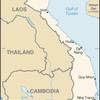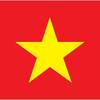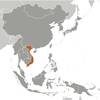Vietnam [+]Compare [E]dit [H]istory
Aliases: Cong Hoa Xa Hoi Chu Nghia Viet Nam, Socialist Republic of Vietnam, Viet NamObject «Vietnam» was created due to
Add new object to «Vietnam» or move existing objects here.
Object «Vietnam» has attributes [Show empty attributes][Hide empty attributes]
| Attribute | Value |
|---|---|
| Geography | |
| Area | 331,210 km² |
| Continent | Asia |
| Land area | 310,070 km² |
| Water area | 21,140 km² |
| Land boundaries | 4,616 km |
| Border countries |
|
| Coastline | 3,444 km |
| Mean elevation | 398 m |
| Lowest point | 0 m |
| Highest point | 3,144 m |
| People | |
| Population | 98,721,275 |
| Official languages |
|
| Religion | Buddhist |
| Government | |
| Long country name | Socialist Republic of Vietnam |
| Short country name | Vietnam |
| Long local name | Cong Hoa Xa Hoi Chu Nghia Viet Nam |
| Short local name | Viet Nam |
| Former name | Add |
| Government type | Communist state |
| Capital | Hanoi |
| Economy | |
| GDP (PPP) | 648,700,000,000 USD |
| GDP (OER) | 220,400,000,000 USD |
| GDP (real growth rate) | 6.8 % |
| GDP - per capita (PPP) | 6,900 USD |
| Gross national saving | 29 % of GDP |
| Labor force | 54,800,000 |
| Unemployment rate | 2.2 % |
| Population below poverty line | 8 % |
| Budget revenues | 54,590,000,000 USD |
| Budget expenditures | 69,370,000,000 USD |
| Military expenditures | 2.3 % of GDP |
| Taxes and other revenues | 24.8 % of GDP |
| Budget surplus or deficit | -6.7 % of GDP |
| Public debt | 58.5 % of GDP |
| Inflation rate | 3.5 % |
| Central bank discount rate | 4.25 % |
| Commercial bank prime lending rate | 7.07 % |
| Stock of narrow money | 85,960,000,000 USD |
| Stock of broad money | 85,960,000,000 USD |
| Stock of domestic credit | 313,000,000,000 USD |
| Market value of publicly traded shares | 156,700,000,000 USD |
| Current account balance | 5,401,000,000 USD |
| Exports | 214,100,000,000 USD |
| Imports | 202,600,000,000 USD |
| Reserves of foreign exchange and gold | 49,500,000,000 USD |
| External debt | 96,580,000,000 USD |
| National currency | dong |
| National currency (code) | VND |
| National currency (symbol) | ₫ |
| National currency rate to USD | 22 |
The conquest of Vietnam by France began in 1858 and was completed by 1884. It became part of French Indochina in 1887. Vietnam declared independence after World War II, but France continued to rule until its 1954 defeat by communist forces under Ho Chi MINH. Under the Geneva Accords of 1954, Vietnam was divided into the communist North and anti-communist South. US economic and military aid to South Vietnam grew through the 1960s in an attempt to bolster the government, but US armed forces were withdrawn following a cease-fire agreement in 1973. Two years later, North Vietnamese forces overran the South reuniting the country under communist rule. Despite the return of peace, for over a decade the country experienced little economic growth because of conservative leadership policies, the persecution and mass exodus of individuals - many of them successful South Vietnamese merchants - and growing international isolation. However, since the enactment of Vietnam's "doi moi" (renovation) policy in 1986, Vietnamese authorities have committed to increased economic liberalization and enacted structural reforms needed to modernize the economy and to produce more competitive, export-driven industries. The communist leaders maintain tight control on political expression but have demonstrated some modest steps toward better protection of human rights. The country continues to experience small-scale protests, the vast majority connected to either land-use issues, calls for increased political space, or the lack of equitable mechanisms for resolving disputes. The small-scale protests in the urban areas are often organized by human rights activists, but many occur in rural areas and involve various ethnic minorities such as the Montagnards of the Central Highlands, Hmong in the Northwest Highlands, and the Khmer Krom in the southern delta region.
Similar objects
Most often compared with
Everyone can something to edit or add.
There was one edit, no edits waiting approval. Last edited by mann.zelma(9435), Sep 16, 2019 (63 fields were changed)
Help · Contact us · Disclaimer · Contributors · Developers · Donate


